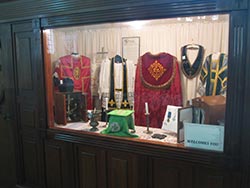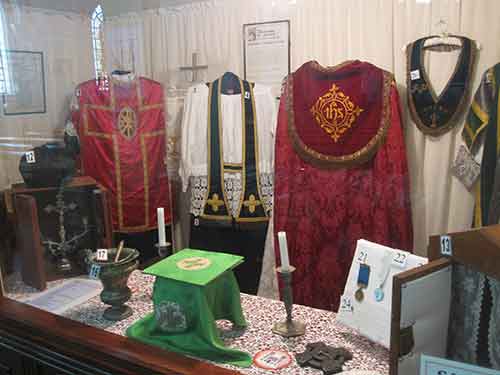 I recently visited a church building which presented ecclesiastical paraphernalia attractively in some cabinets (images). People obviously put love, care, and devotion into making these things. And also gifting them in memory of others.
I recently visited a church building which presented ecclesiastical paraphernalia attractively in some cabinets (images). People obviously put love, care, and devotion into making these things. And also gifting them in memory of others.
When they are no longer appropriate in a renewed context, leaving them in drawers and cupboards to the moths may not be for the best.
But nor should the church be a museum, continuing arcane rituals with such things as burse and veil just because Great Aunt Flo did the embroidery!
I see esoteric rituals (passed on from training vicar to curate, from generation to generation) with the veil removed from chalice and paten, and hung comically on the congregation’s side of the altar, while the burse stands vertically tent-like on the altar – and all with no significance to anyone other than “this is how it is done!”
Here is the alternative: your own church museum.




And of course if the burse is being used for its original(?) purpose as part of extreme crumb-consciousness, the last thing you want to do with it is stand it up open! I have seen older burses still in use where the embroidery appeared upside down when used that way – they were made to lean, open side up, against a candlestick.
Thanks, Chris, for this gem. Blessings.
And a key phrase in Chris’ comment is “against a candlestick.” That’s the most convenient place for the burse to lean at an eastward altar with candlesticks behind. That’s what we do in my church, and use all the “traditional” ceremonial that fits and makes sense in that setting.
The oddity comes when the setting is changed, but a westward altar (possibly without candlesticks either) is used with the same ceremonial. So the burse is stood up so it *looks* the same – and because there is no candlestick it has to be propped open, and the wrong way up, in order to stand up.
Here in England (is this the same elsewhere?) this is an endemic disease of MOTR places. Spiky places tend either to be trad, as were are, and use the things in a sensible way, or modern, and don’t use them at all (though I’ve only once seen a display as in the OP!). But there are lots of places that never use a chasuble but are religious attached to the veil.
Yes, to all that, Fr Simon. Including having places here that would regard the chasuble as unacceptable, but would balk at the idea of stopping playing liturgical camping on the table with burse and veil. Blessings.
We typically use a pall, purificator, and corporal. I’m not sure I’ve served as celebrant at a Eucharist using a burse and veil.
Thanks, Fr Ryan. I can see the point of all three of those. How/when do you use the pall? I have seen that baroquely used. Blessings.
Great post! I think this is what happens when Christianity and church practice are relegated to being merely ‘heritage’. Like you said above it seems many church buildings and institutions are becoming museums to esoteric rituals without any consideration to the why. That is what I have seen in my time at St Johns so far. People will get very upset over the strangest things in worship, and when you ask then why they really cannot tell you (it is not confined to any one tradition either, both high and low are guilty)! We need you up here Bosco to teach us a few things!
Thanks, Jethro. For those beyond NZ’s shores, the St John’s Jethro mentions is our national seminary/theological college. Surely, Jethro, St John’s should be the place of best practice, and the place where the best practice is explained, discussed, studied, and practised? Blessings.
There is the Reformation precedent of re-purposing copes as bedspreads!
Yes, Gareth. And a lot of copes look like they were intended to be bedspreads (or curtains) but have been re-purposed for ecclesiastical dress up. Blessings.
Haha! Yes, indeed.
It is a perpetual danger that any object that spends enough time in the church becomes too sacred to remove. Sometimes the stuff has personal value — someone made it or donated money for it — but most of the time it is just something that was put down and not picked back up. As we have prayers for blessing things (like burses and veils), perhaps we need prayers to recommission them life of useful retirement. Are we in danger of idolatry if we conceive that any artifact is too sacred to retire?
In several parishes I’ve served in we have retired the burse and veil. Often a good way to do this without starting a major war with the embroidery guild is to put their no longer used work on display. I actually quite like it – a visual statement about the church actually embracing change! Plus some of it is quite beautiful.
Yes, exactly, Brian! Thanks & blessings.
Both the church I have just left and the one I am going to don’t have frontals on their altar. So I use burse and veil for the very simple reason that they add a splash of liturgical colour. It both brightens up the service and helps people be aware of the season they are in.
Regarding your liturgical museum photo (and it is of course far more important to be fussy in a museum than in a church) why red vestments with a green burse and veil?
Thanks, Fr Mund. Are you not wearing a stole? Do you put the veil over the edge of the table as I describe so that you end up with a mini-frontal? What would it take for the church you left and the one you are going to to organise some frontals if that is the issur for which the veil is your solution? Blessings.
Perhaps such “taonga” would be better buried with its maker than left secure behind glass as a fossilised memory of faith?
I happily appreciate such ‘wearable art’ as a living form of archaic theatre – familiar yet weird, hinting (at times) of a reality beyond itself. But transferred to safe storage, such paraphernalia is merely odd and incomprehensible.
We should neither rely on the faithfulness of our fathers, nor the creativity of our grandmothers.
I was told that the original purpose of these was to prevent bits of birds’ nests and droppings coming from the rafters into the bread or wine or their containers. (I don’t know all the correct terminology.) While this no longer applies, we still use veil and burse and agree they are a barrier against spiders, ants, flies and other insects etc.
I think the pall, Dorothy, may have that function for the chalice, but cannot see how the burse and veil have that function, eg, for the bread. Blessings.